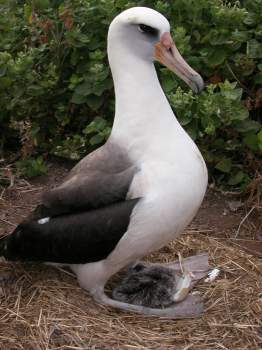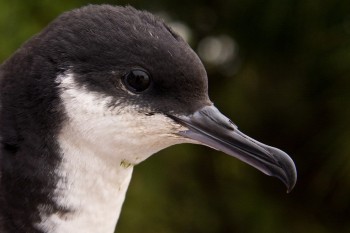SeabirderSaturday will once again have a themed forum discussion. Today Jennifer Provencher (Department of Biology, Carleton University, Ottawa, Canada) will be leading the discussion on seabird and marine litter interactions (click here). To join the discussion, or just learn more about litter and seabirds, join us on Twitter at 1700 - 1900 GMT, and follower #SeabirderSaturday and Jennifer at @jenni_pro.
The discussion is introduced:
“As global travellers seabirds are considered important sentinel species of the world’s oceans. While seabirds are primarily in search of food, increasingly marine birds are also ingesting, getting tangled and incorporating into their nests plastics and other marine debris. Although man-made marine debris has likely been entering the oceans for centuries, plastic, the largest component of marine litter, was initially invented in the early 1900s. By 1988, 30 million tons of plastic was produced annually, with this amount increasing almost 10 fold over since that timae. Interactions between seabirds and marine plastic were first reported in the 1960s, with reports increasing since this time.
Although reports of litter ingestion was first reported [sic] in the 1960s, efforts to standardize, track and monitor the marine debris ingestion by seabirds was pioneered in the North Sea by the ‘Save the North Sea’ group in the early 1990s. While some data series on marine debris ingestion date back to the 1980s, most regions began this phenomenon in the early 2000s. Although initial concerns with marine debris ingestion centred around the physical impacts of ingested debris more recently studies have shown that plastics may also be a vehicle for chemicals, including environmental contaminants shown to have deleterious effects on wildlife. Less work has been done on entanglement and nest incorporation but both have been shown to have negative impacts on seabirds. UNEP has listed marine plastics as an emerging global environmental challenge. Given that seabirds have been shown to be an important group for both environmental monitoring and assessing the impacts of plastics debris on wildlife, seabird research can play a critical role in helping to address and understand this global environmental problem."
n
Black-footed Albatross entangled with a balloon

Laysan Albatrosses can ingest floating plastic artefacts, photograph by Ross Wanless
"Some discussion topics:
- What are the best practices for monitoring and assessing debris ingestion in seabirds worldwide given the variety of: a) seabird foraging strategies, and thus ingestion rates; b) retention of debris; c) methods of bird collections available; and d) method of assessing plastic interactions?
- What effects are ghost nets having on seabird populations globally?
- How do we best assess the impacts of debris on seabirds, both physically and chemically?
- What is the fate of ‘bio’ plastics in the environment and the digestive system of seabirds? Does it break down?
- What long terms studies are available for debris interactions, and what do they tell us?
- What are the emerging questions about plastics that seabird researchers should focus on?
- How do we take information collected to better make population level assessments?
- What geographical areas are lacking in data and coordinated efforts that should be focused on?
- How do we incorporate plastics at sea data into spatial modelling of seabird threats?
- Are regional assessments or summaries of plastic interactions useful to science? To policy makers?
- What form should marine litter data be presented in to be the most useful to policy makers?”
Selected Literature:
Bond, A.L., Montevecchi, W.A., Guse, N., Regular, P.M., Garthe, S. & Rail, J.F. 2012. Prevalence and composition of fishing gear debris in the nests of northern gannets (Morus bassanus) are related to fishing effort. Marine Pollution Bulletin 64: 907-911.
Bond, A.L., Provencher, J.F., Elliot, R., Ryan, P.C., Rowe, S., Jones, I.L., Robertson, G. & Wilhelm, S. 2013. Ingestion of plastic marine debris by common and thick-billed murres in the Northwest Atlantic from 1985 to 2012. Marine Pollution Bulletin 77: 192-195.
Cadee, G.C. 2002. Seabirds and floating plastic debris. Marine Pollution Bulletin 44: 1294-1295.
Good, T.P., June, J.A., Etnier, M.A. & Broadhurst, G. 2010. Derelict fishing nets in Puget Sound and the Northwest Straits: patterns and threats to marine fauna. Marine Pollution Bulletin 60: 39-50.
Kühn, S., Bravo Rebolledo, E.L. & van Franeker, J.A. 2015. Deleterious effects of litter on marine life. In: Bergmann, M., Gutow, L. & Klages, M. (Eds). Marine Anthropogenic Litter. Cham: Springer International. pp. 75-116.
Provencher, J.F., Bond, A.L. & Mallory, M.L. 2015. Marine birds and plastic debris in Canada: a national synthesis and a way forward. Environmental Reviews 23: 1-13.
Ryan, P.G. 2008. Seabirds indicate changes in the composition of plastic litter in the Atlantic and south-western Indian Oceans. Marine Pollution Bulletin 56: 1406-1409.
Ryan, P.G. 2015. A brief history of marine litter research. In: Bergmann, M., Gutow, L. & Klages, M. (Eds). Marine Anthropogenic Litter. New York: Springer International. pp. 1-25.
Ryan, P.G., Moore, C.J., van Franeker, J.A. & Moloney, C.L. 2009. Monitoring the abundance of plastic debris in the marine environment. Philosophical Transactions of the Royal Society B-Biological Sciences 364: 1999-2012.
van Franeker, J.A., Blaize, C., Danielsen, J., Fairclough, K., Gollan, J., Guse, N., Hansen, P.L., Heubeck, M., Jensen, J.K., Le Guillou, G., Olsen, B., Olsen, K.O., Pedersen, J., Stienen, E.W.M. & Turner, D.M. 2011. Monitoring plastic ingestion by the northern fulmar Fulmarus glacialis in the North Sea. Environmental Pollution 159: 2609-2615.
Vegter, A.C., Barletta, M., Beck, C., Borrero, J., Burton, H., Campbell, M.L., Eriksen, M., Eriksson, C., Estrades, A., Gilardi, K., Hardesty, B.D., Ivar do Sul, J.A., Lavers, J.L., Lazar, B., Lebreton, L., Nichols, W.J., Ribic, C.A., Ryan, P.G., Schuyler, Q.A., Smith, S.D.A., Takada, H., Townsend, K.A., Wabnitz, C.C.C., Wilcox, C., Young, L. & Hamann, M. 2014. Global research priorities for the management and mitigation of plastic pollution on marine wildlife. Endangered Species Research 25: 225-247.
Yamashita, R., Takada, H., Fukuwaka, M.A. & Watanuki, Y. 2011. Physical and chemical effects of ingested plastic debris on short-tailed shearwaters, Puffinus tenuirostris, in the North Pacific Ocean. Marine Pollution Bulletin 62: 2845-2849.
John Cooper, ACAP Information officer, 22 August 2015



 English
English  Français
Français  Español
Español 










